Zhihui Lai
Joker: Joint Optimization Framework for Lightweight Kernel Machines
May 23, 2025Abstract:Kernel methods are powerful tools for nonlinear learning with well-established theory. The scalability issue has been their long-standing challenge. Despite the existing success, there are two limitations in large-scale kernel methods: (i) The memory overhead is too high for users to afford; (ii) existing efforts mainly focus on kernel ridge regression (KRR), while other models lack study. In this paper, we propose Joker, a joint optimization framework for diverse kernel models, including KRR, logistic regression, and support vector machines. We design a dual block coordinate descent method with trust region (DBCD-TR) and adopt kernel approximation with randomized features, leading to low memory costs and high efficiency in large-scale learning. Experiments show that Joker saves up to 90\% memory but achieves comparable training time and performance (or even better) than the state-of-the-art methods.
Prototype Contrastive Consistency Learning for Semi-Supervised Medical Image Segmentation
Feb 10, 2025Abstract:Medical image segmentation is a crucial task in medical image analysis, but it can be very challenging especially when there are less labeled data but with large unlabeled data. Contrastive learning has proven to be effective for medical image segmentation in semi-supervised learning by constructing contrastive samples from partial pixels. However, although previous contrastive learning methods can mine semantic information from partial pixels within images, they ignore the whole context information of unlabeled images, which is very important to precise segmentation. In order to solve this problem, we propose a novel prototype contrastive learning method called Prototype Contrastive Consistency Segmentation (PCCS) for semi-supervised medical image segmentation. The core idea is to enforce the prototypes of the same semantic class to be closer and push the prototypes in different semantic classes far away from each other. Specifically, we construct a signed distance map and an uncertainty map from unlabeled images. The signed distance map is used to construct prototypes for contrastive learning, and then we estimate the prototype uncertainty from the uncertainty map as trade-off among prototypes. In order to obtain better prototypes, based on the student-teacher architecture, a new mechanism named prototype updating prototype is designed to assist in updating the prototypes for contrastive learning. In addition, we propose an uncertainty-consistency loss to mine more reliable information from unlabeled data. Extensive experiments on medical image segmentation demonstrate that PCCS achieves better segmentation performance than the state-of-the-art methods. The code is available at https://github.com/comphsh/PCCS.
Precise Facial Landmark Detection by Dynamic Semantic Aggregation Transformer
Dec 01, 2024



Abstract:At present, deep neural network methods have played a dominant role in face alignment field. However, they generally use predefined network structures to predict landmarks, which tends to learn general features and leads to mediocre performance, e.g., they perform well on neutral samples but struggle with faces exhibiting large poses or occlusions. Moreover, they cannot effectively deal with semantic gaps and ambiguities among features at different scales, which may hinder them from learning efficient features. To address the above issues, in this paper, we propose a Dynamic Semantic-Aggregation Transformer (DSAT) for more discriminative and representative feature (i.e., specialized feature) learning. Specifically, a Dynamic Semantic-Aware (DSA) model is first proposed to partition samples into subsets and activate the specific pathways for them by estimating the semantic correlations of feature channels, making it possible to learn specialized features from each subset. Then, a novel Dynamic Semantic Specialization (DSS) model is designed to mine the homogeneous information from features at different scales for eliminating the semantic gap and ambiguities and enhancing the representation ability. Finally, by integrating the DSA model and DSS model into our proposed DSAT in both dynamic architecture and dynamic parameter manners, more specialized features can be learned for achieving more precise face alignment. It is interesting to show that harder samples can be handled by activating more feature channels. Extensive experiments on popular face alignment datasets demonstrate that our proposed DSAT outperforms state-of-the-art models in the literature.Our code is available at https://github.com/GERMINO-LiuHe/DSAT.
Low-Light Enhancement Effect on Classification and Detection: An Empirical Study
Sep 22, 2024Abstract:Low-light images are commonly encountered in real-world scenarios, and numerous low-light image enhancement (LLIE) methods have been proposed to improve the visibility of these images. The primary goal of LLIE is to generate clearer images that are more visually pleasing to humans. However, the impact of LLIE methods in high-level vision tasks, such as image classification and object detection, which rely on high-quality image datasets, is not well {explored}. To explore the impact, we comprehensively evaluate LLIE methods on these high-level vision tasks by utilizing an empirical investigation comprising image classification and object detection experiments. The evaluation reveals a dichotomy: {\textit{While Low-Light Image Enhancement (LLIE) methods enhance human visual interpretation, their effect on computer vision tasks is inconsistent and can sometimes be harmful. }} Our findings suggest a disconnect between image enhancement for human visual perception and for machine analysis, indicating a need for LLIE methods tailored to support high-level vision tasks effectively. This insight is crucial for the development of LLIE techniques that align with the needs of both human and machine vision.
CodeEnhance: A Codebook-Driven Approach for Low-Light Image Enhancement
Apr 08, 2024Abstract:Low-light image enhancement (LLIE) aims to improve low-illumination images. However, existing methods face two challenges: (1) uncertainty in restoration from diverse brightness degradations; (2) loss of texture and color information caused by noise suppression and light enhancement. In this paper, we propose a novel enhancement approach, CodeEnhance, by leveraging quantized priors and image refinement to address these challenges. In particular, we reframe LLIE as learning an image-to-code mapping from low-light images to discrete codebook, which has been learned from high-quality images. To enhance this process, a Semantic Embedding Module (SEM) is introduced to integrate semantic information with low-level features, and a Codebook Shift (CS) mechanism, designed to adapt the pre-learned codebook to better suit the distinct characteristics of our low-light dataset. Additionally, we present an Interactive Feature Transformation (IFT) module to refine texture and color information during image reconstruction, allowing for interactive enhancement based on user preferences. Extensive experiments on both real-world and synthetic benchmarks demonstrate that the incorporation of prior knowledge and controllable information transfer significantly enhances LLIE performance in terms of quality and fidelity. The proposed CodeEnhance exhibits superior robustness to various degradations, including uneven illumination, noise, and color distortion.
NPSVC++: Nonparallel Classifiers Encounter Representation Learning
Feb 08, 2024Abstract:This paper focuses on a specific family of classifiers called nonparallel support vector classifiers (NPSVCs). Different from typical classifiers, the training of an NPSVC involves the minimization of multiple objectives, resulting in the potential concerns of feature suboptimality and class dependency. Consequently, no effective learning scheme has been established to improve NPSVCs' performance through representation learning, especially deep learning. To break this bottleneck, we develop NPSVC++ based on multi-objective optimization, enabling the end-to-end learning of NPSVC and its features. By pursuing Pareto optimality, NPSVC++ theoretically ensures feature optimality across classes, hence effectively overcoming the two issues above. A general learning procedure via duality optimization is proposed, based on which we provide two applicable instances, K-NPSVC++ and D-NPSVC++. The experiments show their superiority over the existing methods and verify the efficacy of NPSVC++.
Computational Technologies for Fashion Recommendation: A Survey
Jun 06, 2023



Abstract:Fashion recommendation is a key research field in computational fashion research and has attracted considerable interest in the computer vision, multimedia, and information retrieval communities in recent years. Due to the great demand for applications, various fashion recommendation tasks, such as personalized fashion product recommendation, complementary (mix-and-match) recommendation, and outfit recommendation, have been posed and explored in the literature. The continuing research attention and advances impel us to look back and in-depth into the field for a better understanding. In this paper, we comprehensively review recent research efforts on fashion recommendation from a technological perspective. We first introduce fashion recommendation at a macro level and analyse its characteristics and differences with general recommendation tasks. We then clearly categorize different fashion recommendation efforts into several sub-tasks and focus on each sub-task in terms of its problem formulation, research focus, state-of-the-art methods, and limitations. We also summarize the datasets proposed in the literature for use in fashion recommendation studies to give readers a brief illustration. Finally, we discuss several promising directions for future research in this field. Overall, this survey systematically reviews the development of fashion recommendation research. It also discusses the current limitations and gaps between academic research and the real needs of the fashion industry. In the process, we offer a deep insight into how the fashion industry could benefit from fashion recommendation technologies. the computational technologies of fashion recommendation.
Precise Facial Landmark Detection by Reference Heatmap Transformer
Mar 14, 2023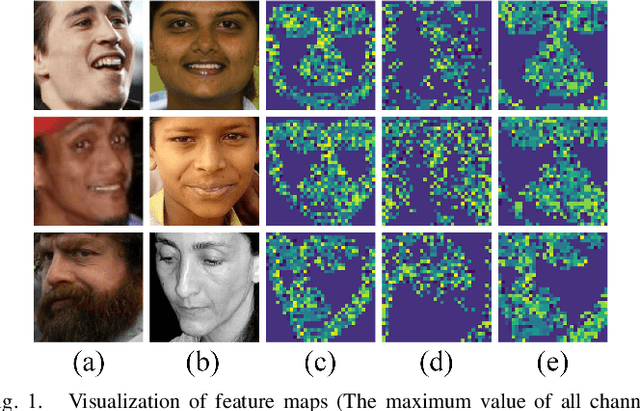
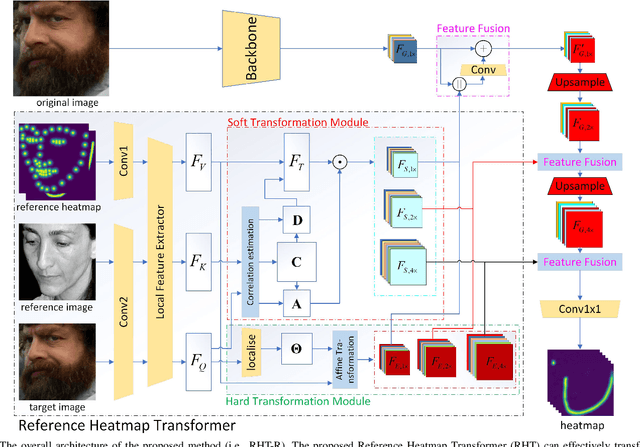
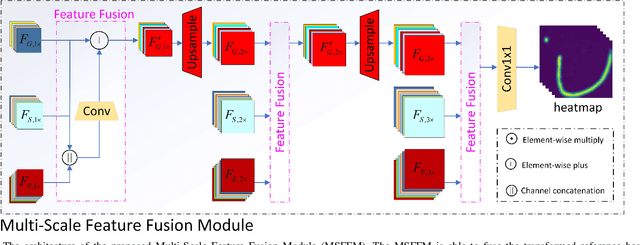
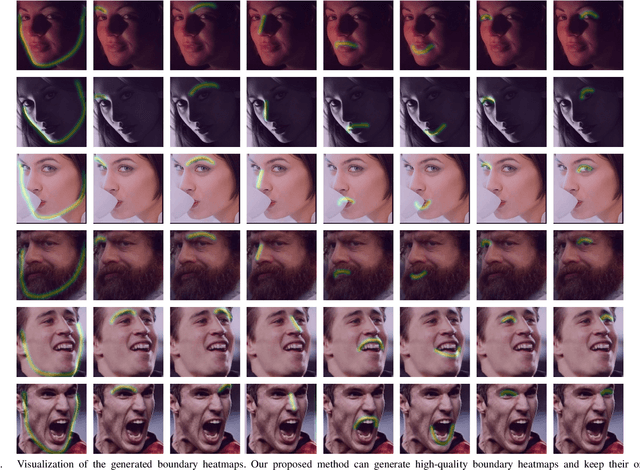
Abstract:Most facial landmark detection methods predict landmarks by mapping the input facial appearance features to landmark heatmaps and have achieved promising results. However, when the face image is suffering from large poses, heavy occlusions and complicated illuminations, they cannot learn discriminative feature representations and effective facial shape constraints, nor can they accurately predict the value of each element in the landmark heatmap, limiting their detection accuracy. To address this problem, we propose a novel Reference Heatmap Transformer (RHT) by introducing reference heatmap information for more precise facial landmark detection. The proposed RHT consists of a Soft Transformation Module (STM) and a Hard Transformation Module (HTM), which can cooperate with each other to encourage the accurate transformation of the reference heatmap information and facial shape constraints. Then, a Multi-Scale Feature Fusion Module (MSFFM) is proposed to fuse the transformed heatmap features and the semantic features learned from the original face images to enhance feature representations for producing more accurate target heatmaps. To the best of our knowledge, this is the first study to explore how to enhance facial landmark detection by transforming the reference heatmap information. The experimental results from challenging benchmark datasets demonstrate that our proposed method outperforms the state-of-the-art methods in the literature.
Asymmetric Transfer Hashing with Adaptive Bipartite Graph Learning
Jun 25, 2022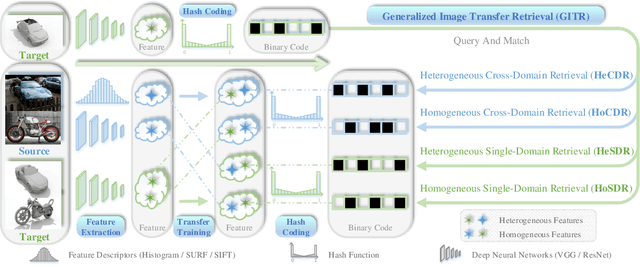
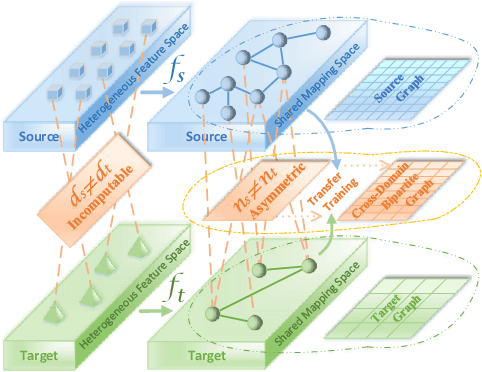


Abstract:Thanks to the efficient retrieval speed and low storage consumption, learning to hash has been widely used in visual retrieval tasks. However, existing hashing methods assume that the query and retrieval samples lie in homogeneous feature space within the same domain. As a result, they cannot be directly applied to heterogeneous cross-domain retrieval. In this paper, we propose a Generalized Image Transfer Retrieval (GITR) problem, which encounters two crucial bottlenecks: 1) the query and retrieval samples may come from different domains, leading to an inevitable {domain distribution gap}; 2) the features of the two domains may be heterogeneous or misaligned, bringing up an additional {feature gap}. To address the GITR problem, we propose an Asymmetric Transfer Hashing (ATH) framework with its unsupervised/semi-supervised/supervised realizations. Specifically, ATH characterizes the domain distribution gap by the discrepancy between two asymmetric hash functions, and minimizes the feature gap with the help of a novel adaptive bipartite graph constructed on cross-domain data. By jointly optimizing asymmetric hash functions and the bipartite graph, not only can knowledge transfer be achieved but information loss caused by feature alignment can also be avoided. Meanwhile, to alleviate negative transfer, the intrinsic geometrical structure of single-domain data is preserved by involving a domain affinity graph. Extensive experiments on both single-domain and cross-domain benchmarks under different GITR subtasks indicate the superiority of our ATH method in comparison with the state-of-the-art hashing methods.
Robust and Precise Facial Landmark Detection by Self-Calibrated Pose Attention Network
Dec 23, 2021



Abstract:Current fully-supervised facial landmark detection methods have progressed rapidly and achieved remarkable performance. However, they still suffer when coping with faces under large poses and heavy occlusions for inaccurate facial shape constraints and insufficient labeled training samples. In this paper, we propose a semi-supervised framework, i.e., a Self-Calibrated Pose Attention Network (SCPAN) to achieve more robust and precise facial landmark detection in challenging scenarios. To be specific, a Boundary-Aware Landmark Intensity (BALI) field is proposed to model more effective facial shape constraints by fusing boundary and landmark intensity field information. Moreover, a Self-Calibrated Pose Attention (SCPA) model is designed to provide a self-learned objective function that enforces intermediate supervision without label information by introducing a self-calibrated mechanism and a pose attention mask. We show that by integrating the BALI fields and SCPA model into a novel self-calibrated pose attention network, more facial prior knowledge can be learned and the detection accuracy and robustness of our method for faces with large poses and heavy occlusions have been improved. The experimental results obtained for challenging benchmark datasets demonstrate that our approach outperforms state-of-the-art methods in the literature.
 Add to Chrome
Add to Chrome Add to Firefox
Add to Firefox Add to Edge
Add to Edge